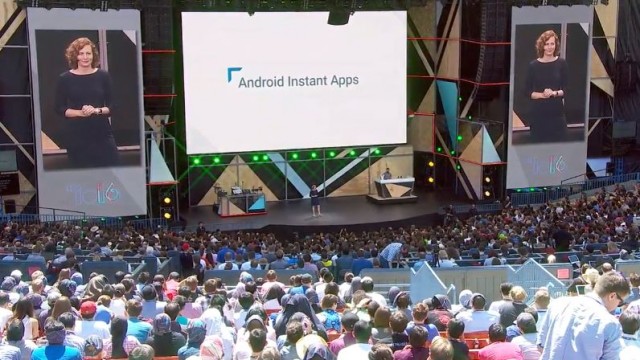Back at Google IO 2016, Google announced a feature that could change the mobile marketing game: instant apps. These are “mini-apps” that launch when a user clicks a web link while browsing on mobile. That link launches a modular piece of a full app, that could get up and running faster than a full app. Just recently, Google announced that the first batch of Instant Apps are ready for testing. Buzzfeed, Periscope, Wish, and a few more apps are the first to take the plunge, so keep an eye out for updates about user response.

Google announced Instant Apps at IO 2016.
Since we haven’t seen anything like this in the mobile space before, you probably have a few questions. And what’s better than a good list to tackle them all at once?
1. What makes instant apps different from regular apps?
You don’t have to download the full app.Only the piece with the functionality you’re looking to use. That means less to download, so you can take the action you want, faster.
Functionality is specific and limited. With an instant app, you only have access to the part of an app that’s required to perform a specific task. For example, buying a product or booking a parking space. If a user wants to access some kind of functionality or content that isn’t available in the instant app, they’ll get a prompt to download the complete app.
Like the apps you already have on your phone, native functionality makes them faster and easier to use than a website.
2. Who can use or develop instant apps?
Anyone with an Android phone. Instant apps are limited to Android operating systems for now. Apple hasn’t confirmed when or if they’ll be offering their version.
3. So I have to ask an app developer to build another app for me? That doesn’t sound great.
It’s less work than it sounds. According to Google, you use the same API and source code to create your Instant App. This work will vary depending on your app–simpler apps will require less effort to distill into an Instant App–but essentially all your developer has to do is “modularize” your app, based on functions. When a user downloads the Instant App that appears according to a search, it only downloads the module needed to pay for tickets (for example).
4. Why does Google think they’re good for mobile users?
The steps needed to use an app you don’t already have on your phone–downloading, opening the app, maybe logging in–are taken out of the equation.
5. How do they fit into a mobile marketing ecosystem?
We’re not sure yet! It really depends whether users embrace instant apps, and if they do, how they use them. To us, the biggest question is if users will use instant apps instead of downloading the full app or if instant apps will act as an acquisition strategy. So depending on how they’re used, instant apps could take on two very different roles in the mobile marketing ecosystem.
On the other hand, mobile marketers could see instant apps as an opportunity to introduce new potential users to their app, since there’s a low barrier to access. But that’s likely your one opportunity to get them to download, and in-app messaging could be a powerful way to connect with instant app users before they move on.
6. Why would I want to have a “lite” version of my app?
Traditionally, the need to go into the app store and download the app has acted as a friction point that may have kept a user from converting–booking the flight, reserving the table, buying the tickets. With instant apps, you remove that barrier while providing a better user experience than going through a mobile site.
Instant apps at work. Source
7. What does it mean for app owners?
Right now, we’ll have to wait and see. Understandably, Android app owners are worried about what they mean for app revenue, which typically comes from paying for downloads or building user relationships that offer value over time. It’s not yet clear whether or not instant apps will damage the ability to generate revenue, but we’ll be keeping an eye on what happens.
8. What industries should be considering Instant apps right now?
They’re a great fit for retail and travel industries, which typically encounter users who want to make a one-time purchase or don’t otherwise see themselves using a full app regularly.
9. What should mobile marketers keep in mind when it comes to Instant Apps?
App users are generally one of your most engaged audiences, right? They want fast, easy access to your brand from the device that’s pretty much an extension of self–their mobile phone or tablet. But instant app users will be a little different; you’re effectively widening the top of your funnel. You’re connecting with users who, without instant apps, may not have interacted with your brand, because they didn’t want to download your app to take whatever action they wanted to take.
10. How can marketers take advantage?
Think of an instant app as the gateway to your regular app–and more important, your brand. If a user has a positive experience in your instant app, and you
1.) Prove your app’s value
2.) Entice them with additional content or value that only your full app provides
Instant apps can be a great thing. You’ll have another path to conversion, and a new way of reaching potential app users.
We’ll sum it up: Instant apps don’t replace a full-stack app. But for mobile marketers, they’re a powerful way to ease the path to conversion, with the potential to build a positive association with your brand.

